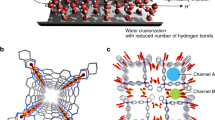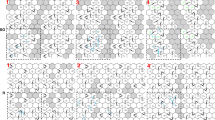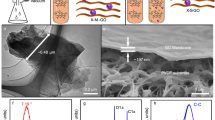Abstract
Water in nanoscale cavities is ubiquitous and of central importance to everyday phenomena in geology and biology. However, the properties of nanoscale water can be substantially different from those of bulk water, as shown, for example, by the anomalously low dielectric constant of water in nanochannels1, near frictionless water flow2 or the possible existence of a square ice phase3. Such properties suggest that nanoconfined water could be engineered for technological applications in nanofluidics4, electrolyte materials5 and water desalination6. Unfortunately, challenges in experimentally characterizing water at the nanoscale and the high cost of first-principles simulations have prevented the molecular-level understanding required to control the behaviour of water. Here we combine a range of computational approaches to enable a first-principles-level investigation of a single layer of water within a graphene-like channel. We find that monolayer water exhibits surprisingly rich and diverse phase behaviour that is highly sensitive to temperature and the van der Waals pressure acting within the nanochannel. In addition to multiple molecular phases with melting temperatures varying non-monotonically by more than 400 kelvins with pressure, we predict a hexatic phase, which is an intermediate between a solid and a liquid, and a superionic phase with a high electrical conductivity exceeding that of battery materials. Notably, this suggests that nanoconfinement could be a promising route towards superionic behaviour under easily accessible conditions.
This is a preview of subscription content, access via your institution
Access options
Access Nature and 54 other Nature Portfolio journals
Get Nature+, our best-value online-access subscription
$29.99 / 30 days
cancel any time
Subscribe to this journal
Receive 51 print issues and online access
$199.00 per year
only $3.90 per issue
Buy this article
- Purchase on Springer Link
- Instant access to full article PDF
Prices may be subject to local taxes which are calculated during checkout



Similar content being viewed by others
Data availability
The initial structures required to reproduce the key findings of this work are available at GitHub (https://github.com/venkatkapil24/data-monolayer-confined-water-phase-diagram/).
Code availability
The scripts and codes to reproduce the key findings of this work are available at GitHub (https://github.com/venkatkapil24/data-monolayer-confined-water-phase-diagram/).
References
Fumagalli, L. et al. Anomalously low dielectric constant of confined water. Science 360, 1339–1342 (2018).
Secchi, E. et al. Massive radius-dependent flow slippage in carbon nanotubes. Nature 537, 210–213 (2016).
Algara-Siller, G. et al. Square ice in graphene nanocapillaries. Nature 519, 443–445 (2015).
Kavokine, N., Bocquet, M.-L. & Bocquet, L. Fluctuation-induced quantum friction in nanoscale water flows. Nature 602, 84–90 (2022).
Hummer, G., Rasaiah, J. C. & Noworyta, J. P. Water conduction through the hydrophobic channel of a carbon nanotube. Nature 414, 188–190 (2001).
Surwade, S. P. et al. Water desalination using nanoporous single-layer graphene. Nat. Nanotechnol. 10, 459–464 (2015).
Radha, B. et al. Molecular transport through capillaries made with atomic-scale precision. Nature 538, 222–225 (2016).
Geim, A. K. & Grigorieva, I. V. Van der Waals heterostructures. Nature 499, 419–425 (2013).
Niguès, A., Siria, A., Vincent, P., Poncharal, P. & Bocquet, L. Ultrahigh interlayer friction in multiwalled boron nitride nanotubes. Nat. Mater. 13, 688–693 (2014).
Zhu, Y., Wang, F. & Wu, H. Superheating of monolayer ice in graphene nanocapillaries. J. Chem. Phys. 146, 134703 (2017).
Li, S. & Schmidt, B. Replica exchange MD simulations of two-dimensional water in graphene nanocapillaries: rhombic versus square structures, proton ordering, and phase transitions. Phys. Chem. Chem. Phys. 21, 17640–17654 (2019).
Millot, M. et al. Nanosecond X-ray diffraction of shock-compressed superionic water ice. Nature 569, 251–255 (2019).
Millot, M. et al. Experimental evidence for superionic water ice using shock compression. Nat. Phys. 14, 297–302 (2018).
Jiang, J. et al. First-principles molecular dynamics simulations of the spontaneous freezing transition of 2D water in a nanoslit. J. Am. Chem. Soc. 143, 8177–8183 (2021).
Zen, A. et al. Fast and accurate quantum Monte Carlo for molecular crystals. Proc. Natl Acad. Sci. USA 115, 1724–1729 (2018).
Schran, C. et al. Machine learning potentials for complex aqueous systems made simple. Proc. Natl Acad. Sci. USA 118, e2110077118 (2021).
Corsetti, F., Matthews, P. & Artacho, E. Structural and configurational properties of nanoconfined monolayer ice from first principles. Sci. Rep. 6, 18651 (2016).
Chen, J., Schusteritsch, G., Pickard, C. J., Salzmann, C. G. & Michaelides, A. Two dimensional ice from first principles: structures and phase transitions. Phys. Rev. Lett. 116, 025501 (2016).
Björkman, T., Gulans, A., Krasheninnikov, A. V. & Nieminen, R. M. van der Waals bonding in layered compounds from advanced density-functional first-principles calculations. Phys. Rev. Lett. 108, 235502 (2012).
Zamborlini, G. et al. Nanobubbles at GPa pressure under graphene. Nano Lett. 15, 6162–6169 (2015).
Chen, J., Zen, A., Brandenburg, J. G., Alfè, D. & Michaelides, A. Evidence for stable square ice from quantum Monte Carlo. Phys. Rev. B 94, 220102 (2016).
Pickard, C. J. & Needs, R. J. Ab initio random structure searching. J. Phys. Condens. Matter 23, 053201 (2011).
Kapil, V. & Engel, E. A. A complete description of thermodynamic stabilities of molecular crystals. Proc. Natl Acad. Sci. USA 119, e2111769119 (2022).
Ferguson, A. L., Giovambattista, N., Rossky, P. J., Panagiotopoulos, A. Z. & Debenedetti, P. G. A computational investigation of the phase behavior and capillary sublimation of water confined between nanoscale hydrophobic plates. J. Chem. Phys. 137, 144501 (2012).
Kosterlitz, J. M. & Thouless, D. J. Ordering, metastability and phase transitions in two-dimensional systems. J. Phys. C Solid State Phys. 6, 1181–1203 (1973).
Pickard, C. J. & Needs, R. J. Structure of phase III of solid hydrogen. Nat. Phys. 3, 473–476 (2007).
Vilanova, O. & Franzese, G. Structural and dynamical properties of nanoconfined supercooled water. Preprint at arXiv http://arxiv.org/abs/1102.2864 (2011).
Muñoz-Santiburcio, D. & Marx, D. Confinement-controlled aqueous chemistry within nanometric slit pores. Chem. Rev. 121, 6293–6320 (2021).
Kreuer, K.-D. Proton conductivity: materials and applications. Chem. Mater. 8, 610–641 (1996).
Sugimura, E. et al. Experimental evidence of superionic conduction in H2O ice. J. Chem. Phys.s 137, 194505 (2012).
Cheng, B., Engel, E. A., Behler, J., Dellago, C. & Ceriotti, M. Ab initio thermodynamics of liquid and solid water. Proc. Natl Acad. Sci. 116, 1110–1115 (2019).
Behler, J. Four generations of high-dimensional neural network potentials. Chem. Rev. https://doi.org/10.1021/acs.chemrev.0c00868 (2021).
Schran, C., Brezina, K. & Marsalek, O. Committee neural network potentials control generalization errors and enable active learning. J. Chem. Phys. 153, 104105 (2020).
Conde, M. M., Gonzalez, M. A., Abascal, J. L. F. & Vega, C. Determining the phase diagram of water from direct coexistence simulations: the phase diagram of the TIP4P/2005 model revisited. J. Chem. Phys. 139, 154505 (2013).
Kapil, V. et al. Universal Force Engine For Advanced Molecular Simulations.Comput. Phys. Commun. 236, 214–223 (2019).
Singraber, A., Behler, J. & Dellago, C. Library-based LAMMPS implementation of high-dimensional neural network potentials. J. Chem. Theory Comput. 15, 1827–1840 (2019).
Larsen, A. H.et al. The atomic simulation environment—a Python library for working with atoms. J. Phys. Condens. Matter 29, 273002 (2017).
Grasselli, F. & Baroni, S. Topological quantization and gauge invariance of charge transport in liquid insulators. Nat. Phys. 15, 967–972 (2019).
Kühne, T. D. et al. CP2K: an electronic structure and molecular dynamics software package—Quickstep: efficient and accurate electronic structure calculations. J. Chem. Phys. 152, 194103 (2020).
Marsalek, O. & Markland, T. E. Quantum dynamics and spectroscopy of ab initio liquid water: the interplay of nuclear and electronic quantum effects. J. Phys. Chem. Lett. 8, 1545–1551 (2017).
Needs, R. J., Towler, M. D., Drummond, N. D. & Rios, P. L. Continuum variational and diffusion quantum Monte Carlo calculations. J. Phys. Condens. Matter 22, 023201 (2010).
Mitas, L., Shirley, E. L. & Ceperley, D. M. Nonlocal pseudopotentials and diffusion Monte Carlo. J. Chem. Phys. 95, 3467 (1991).
Brandenburg, J. G. et al. Physisorption of water on graphene: subchemical accuracy from many-body electronic structure methods. J. Phys. Chem. Lett. 10, 358–368 (2019).
Acknowledgements
We thank D. Frenkel for discussions; D. M. Wilkins for providing the code to study the angular orientation of water; F. L. Thiemann for help with hydrogen bond analysis; M. Davies for help with visualization and graphics; P. Ravindra for reading the manuscript; and the staff at the UK Materials and Molecular Modelling Hub for computational resources, which is partially funded by Engineering and Physical Sciences Research Council (grants EP/P020194/1 and EP/T022213/1). V.K. acknowledges funding from the Swiss National Science Foundation (SNSF) under project P2ELP2_191678 and the Ernest Oppenheimer Fund, allocation of CPU hours by CSCS under Project ID s1000 and support from Churchill College, University of Cambridge. C.S. acknowledges financial support from the Alexander von Humboldt Stiftung. A.Z. acknowledges financial support from the Leverhulme Trust (grant number RPG-2020-038). Calculations were also performed on the Cambridge Service for Data Driven Discovery (CSD3) operated by the University of Cambridge Research Computing Service (www.csd3.cam.ac.uk), provided by Dell EMC and Intel using Tier-2 funding from the Engineering and Physical Sciences Research Council (capital grant EP/P020259/1), and DiRAC funding from the Science and Technology Facilities Council (www.dirac.ac.uk). J.C. acknowledges funding from the National Natural Science Foundation of China under grant no. 11974024, and the Strategic Priority Research Program of Chinese Academy of Sciences under grant no. XDB33000000.
Author information
Authors and Affiliations
Contributions
V.K. and A.M. conceived the study. V.K. and C.S. developed the MLP. V.K., J.C. and C.J.P. implemented and performed structure search using the RSS scheme with the MLP. V.K. performed MLP simulations. J.C. performed first-principles simulations. A.Z. performed QMC calculations. V.K., C.S and AM analysed the data, designed the figures and wrote the paper. All of the authors discussed the results and commented on the manuscript.
Corresponding authors
Ethics declarations
Competing interests
The authors declare no competing interests.
Peer review
Peer review information
Nature thanks Davide Donadio, Greg Kimmel and the other, anonymous, reviewer(s) for their contribution to the peer review of this work. Peer reviewer reports are available.
Additional information
Publisher’s note Springer Nature remains neutral with regard to jurisdictional claims in published maps and institutional affiliations.
Extended data figures and tables
Extended Data Fig. 1 Active learning workflow of the machine learning potential across the full phase diagram.
(a) As depicted in the schematic, the main idea behind the machine learning potential is the combination of multiple neural network potentials (NNPs) in a “committee model”33, where the committee members are separately trained by random subsampling of the training set. Here we use a committee of 8 neural network potentials. The committee average provides more accurate predictions than the individual NNPs, and the committee disagreement, the standard deviation across the committee, is an estimate of the error of the model. To construct a training set of such a model in an automated and data-driven way, new configurations with the highest disagreement can be added to the training set. This approach is known as “query by committee” (QbC). (b) As shown in the schematic, the development of MLPs for various phase points is performed across different “generations", such that in each generation new thermodynamic state points are targeted to yield an MLP which is used to sample new candidate structures for the next generation. We used the bulk water potential from ref. 33, trained on 814 configurations of liquid water, different ice phases, and the water-vacuum interface, all including nuclear quantum effects. In the next generation we added 521 new structures of classical and path integral NPT simulations of monolayer, bilayer water, bulk water and hexagonal ice (100–400 K and 0–1 GPa), ice VII and ice VIII (100–400 K and 0.8–10 GPa), and two sets of monolayer and bilayer ice structures from ref. 18. In the final generation we added 207 structures from classical and path integral NPT temperature and pressure ramps of monolayer water (100–400 K and 0–5 GPa). We obtain an energy and force root mean square error (RMSE) for the training set of 2.4 meV per H2O (or 0.2 kJ mol−1) and 75.4 meV Å−1, respectively. (c) Force (top) and energy (bottom) root mean square error (RMSE) of an independent validation set covering the explored phase diagram of mono-layer confined water. The largest force RMSE for this validation set is with 100 meV Å−1, suggesting that the model remains accurate and robust across a wide range of temperature and pressure. The new model also keeps its excellent performance for the original condensed phase conditions, as noted by a predicted density of 0.93 kg l−1 and a melting temperature of 270 ± 5 K at ambient pressure, in excellent agreement with the reference functional31.
Extended Data Fig. 2 Monolayer ice phases.
(a) Top and side view of the monolayer hexagonal phase.(b) Top and side view of the monolayer pentagonal phase. (c) Top and side view of the monolayer flat-rhombic phase. (d) Top and side view of the monolayer square phase. Lattice constants are labelled along cell vectors. Insets show histograms of O–H distances and H–O–H angles for the optimized structures following the approach from ref. 18.
Extended Data Fig. 3 Zero temperature (classical) phase diagram at quantum Monte Carlo level.
The pressure dependence of the lattice enthalpies of the pentagonal (red) and square (pink) phases relative to the flat-rhombic (green) phase calculated at QMC level. Error bars indicate stochastic QMC error.
Extended Data Fig. 4 Sensitivity analysis of coexistence lines with respect to finite size and quantum nuclear effects.
(a) The temperature dependence of the potential energy for simulations initialized with monolayer hexagonal, pentagonal and flat-rhombic ice phases simulations at 0 pressure, 0.5 GPa and 1.0 GPa respectively. The number of water molecules in the simulation cell are indicated in the legend, with larger (smaller) marker sizes corresponding to larger (smaller) system sizes. The potential energy of the curves have been translated vertically to make it easier to discern the temperature of melting (indicated by a vertical dashed line) for different systems sizes. Shaded regions indicate statistical uncertainty. (b) The temperature dependence of the potential energy for simulations initialized with monolayer hexagonal, pentagonal and flat-rhombic ice phases at 0 pressure, 0.5 GPa and 1.0 GPa respectively, with nuclear quantum effects. Shaded regions indicate statistical uncertainty and the melting temperature is indicated by a vertical dashed line. (c) The structure factor of monolayer confined water in the hexatic phase (400 K) and at the transition between the hexatic and the liquid phase (500 K), without nuclear quantum effects. (d) The structure factor of monolayer confined water in the hexatic phase (400 K) and at the transition between the hexatic and the liquid phase (500 K), with nuclear quantum effects.
Extended Data Fig. 5 Rotational dynamics of monolayer hexatic water.
(a) 1st order orientational autocorrelation function of the hexatic phase at 1 GPa from 340 to 400 K calculated as C1(t) = 〈P1[v(0) ⋅ v(t)]〉 > where, v(t) is the orientation of the O–H bond at time t, and P1 is the Legendre polynomial of degree one. (b) Temperature dependence of the 1st order orientational relaxation time, computed as the time integral of C1(t), for the O–H molecular axis of the hexatic phase at 1 GPa. The relaxation time at 340 K is around seven times smaller than that of room temperature liquid water, indicating facile rotation of water molecules in the hexatic-like phase. (c) The vibrational density of states across the flat-rhombic (up to 320 K) to the hexatic-like phase transition (beyond 340 K) as calculated by the Fourier transform of the velocity autocorrelation function. The flat-rhombic phase is characterized by two distinct vibrational bands for hydrogen bonded and dangling O–H bonds, and clear features for the librational modes. On the other hand, the rotations in the hexatic-like phase merge the two stretching bands into a doublet, and smear out the fine structure of the librational band.
Supplementary information
Supplementary Video 1
Trajectory of monolayer nanoconfined water exhibiting the coexistence of the hexagonal and the liquid phases, and the pentagonal and the liquid phases, at 0.05 GPa and 160 K.
Supplementary Video 2
Trajectory of monolayer nanoconfined water exhibiting the coexistence of the flat-rhombic and the liquid phases, and the pentagonal and the liquid phases, at 0.20 GPa and 170 K.
Supplementary Video 3
Top and side views of the hexatic phase of monolayer nanoconfined water at 1.00 GPa and 340 K, exhibiting facile rotation of non-diffusing water molecules.
Supplementary Video 4
Top and side views of the superionic phase of monolayer nanoconfined water at 4.00 GPa and 600 K, exhibiting facile O–H dissociation. Oxygen ions (4 arbitrarily chosen ones marked in blue) vibrate at their lattice positions, while protons (4 arbitrarily chosen ones marked in yellow) diffuse across the oxygen lattice.
Supplementary Video 5
First-principles simulation of the superionic phase, corresponding to the 4.00 GPa and 600 K state point, in the presence of explicit carbon atoms at the revPBE0-D3 level of theory. While we observe dissociation in a 10 ps timescale we do not see any reactivity of the proton with the carbon atoms.
Supplementary Video 6
First-principles simulation of the hexatic phase, corresponding to the 1.00 GPa and 340 K state point, in the presence of explicit carbon atoms at the revPBE0-D3 level of theory.
Rights and permissions
Springer Nature or its licensor holds exclusive rights to this article under a publishing agreement with the author(s) or other rightsholder(s); author self-archiving of the accepted manuscript version of this article is solely governed by the terms of such publishing agreement and applicable law.
About this article
Cite this article
Kapil, V., Schran, C., Zen, A. et al. The first-principles phase diagram of monolayer nanoconfined water. Nature 609, 512–516 (2022). https://doi.org/10.1038/s41586-022-05036-x
Received:
Accepted:
Published:
Issue Date:
DOI: https://doi.org/10.1038/s41586-022-05036-x
This article is cited by
-
Nanoconfinement-triggered oligomerization pathway for efficient removal of phenolic pollutants via a Fenton-like reaction
Nature Communications (2024)
-
Rich proton dynamics and phase behaviours of nanoconfined ices
Nature Physics (2024)
-
Orbital elasticity control of phase diagram for La0.67Sr0.33MnO3 films
Science China Materials (2024)
-
2H-NMR study of molecular reorientation of D2O confined into the slit-shaped micropores of activated carbon fiber
Adsorption (2024)
-
Hyperactive learning for data-driven interatomic potentials
npj Computational Materials (2023)
Comments
By submitting a comment you agree to abide by our Terms and Community Guidelines. If you find something abusive or that does not comply with our terms or guidelines please flag it as inappropriate.



